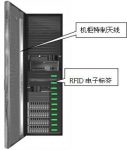
RFID cabinet realizes accurate and rapid grasp of important fixed asset information
[ad_1]
With the rapid development of IT technology and communication technology, some data centers, communication base stations, communication computer rooms, various mobile, telecommunications, radio and television, private networks, and enterprise networks have gradually expanded in accordance with market demand. As there are more and more equipment in the computer room, it becomes more and more difficult to manage. Some equipment inside the cabinet has dense equipment and complicated wiring. If you want to manually manage the equipment in the cabinet (such as hosts, switches, etc.), it can be imagined that the degree of management is relatively high. RFID technology has many advantages such as waterproof, anti-magnetic, high temperature resistance, long service life, large reading distance, data on the label can be encrypted, storage data capacity larger, and storage information can be changed freely. At present, RFID technology has broad application prospects in various industries such as production, retail, logistics, and transportation, and has huge advantages in the field of equipment management in the computer room. The RFID cabinet realizes accurate and rapid grasp of important fixed asset information.
RFID is a kind of radio frequency identification technology, which is composed of readers, antennas and tags. When the tag is close to the sensing range formed by the reader and antenna, the tag will send the data stored in the chip to the reader, and the reader will upload the data to the information system. Due to the large amount of stored data, fast reading speed, and no need for human intervention in the process of reading data, RFID can perform rapid asset identification and inventory, and achieve accurate and rapid grasp of important fixed asset information.

RFID system architecture
The system hardware architecture includes: fixed readers, antennas, RFID handheld devices, tags and back-end servers;
Data exchange method: It can be implemented in two ways, one of which is selected according to cost requirements:
Online data exchange, real-time transmission of field data back to the background information system for processing and analysis through a fixed reader/writer;
Offline data exchange, after collecting the data in the field through the handheld device, import it to the background information system for processing and analysis;
Basic information management
Regional information, computer room information, cabinet information, coding rules, server information, printing styles;
system maintenance
* Data backup, operator, password modification, system log;
Computer room management
* Cabinet query, warehouse entry and exit order, warehouse entry and exit list, inventory, report center;
Server management
* Server increase, server decrease, usage, configuration list, report center;
Operation and maintenance management
* Server repair and regular maintenance;
* Handheld device data import;
Server enters the computer room
After querying the location of the cabinet in the computer room where the system server is placed, a list of production warehousing operations. The job list must at least include information such as the cabinet number and server number. The operation and maintenance personnel transport the server to the designated computer room according to the requirements of the operation list, and the personnel on duty in the computer room confirm the warehousing operation through the warehousing work order generated by the RFID handset. After the operation and maintenance personnel put the server in the designated location according to the requirements of the warehousing operation sheet, scan the cabinet number and server number through the RFID handheld to confirm that the operation is correct and complete the warehousing operation list. The staff on duty in the computer room confirms the cabinet number, server number and server location through the RFID handset to complete the warehousing work order.
Computer room inventory
The person on duty in the computer room opens the system inventory interface and imports the inventory information to the RFID handset. The staff on duty first read the RFID tags of the cabinets for confirmation, and then read the tags of the servers in the cabinets in turn. If the tag data read in the cabinet is consistent with the inventory data imported to the handheld, the interface will be green, indicating that it is passed. If the inconsistent handset interface shows a red interface to indicate failure, you can choose to restart the inventory or end the inventory after checking. Finally, import the inventory data into the system.
RFID technology has a safe and reliable cabinet management method, which solves the loose and troublesome man-made management methods, reduces the difficulty of the management of servers and other equipment, increases the service life of server equipment, and makes the server system run stably.
[ad_2]



